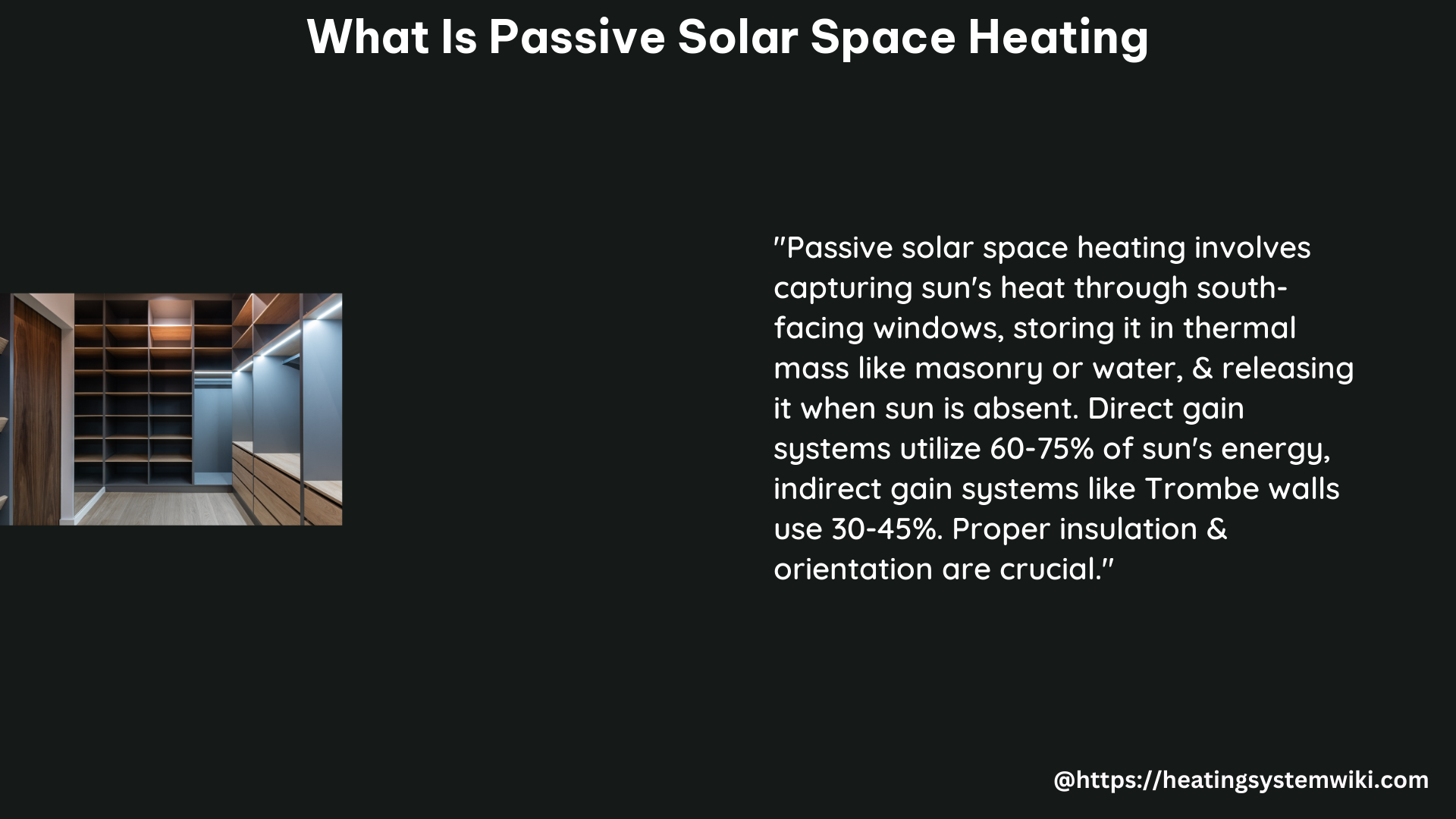Passive solar space heating is a sustainable and energy-efficient approach to heating buildings by harnessing the power of the sun. This method utilizes the strategic design and orientation of a building to capture, store, and distribute solar heat gains without the use of mechanical or electrical devices. The primary components of a passive solar heating system include the aperture (collector), absorber, thermal mass, distribution, and control elements.
Aperture (Collector)
The aperture, often south-facing windows, is responsible for collecting the incoming solar radiation. The size, placement, and glazing type of these windows play a crucial role in maximizing the solar heat gain. Typically, the aperture should occupy 12-20% of the total floor area of the space being heated, with the optimal window-to-floor ratio depending on the climate and building design.
Absorber

The absorber is a dark-colored surface that absorbs and stores the solar energy collected through the aperture. Common absorber materials include masonry walls, floors, or water containers. The absorber’s high thermal mass allows it to store the heat, which can then be released gradually to maintain a comfortable room temperature.
Thermal Mass
Thermal mass refers to the materials within the building that can store and release heat. Ideal thermal mass materials include concrete, brick, stone, and water. The amount and placement of thermal mass are critical factors in passive solar design, as they determine the system’s ability to store and release heat effectively. Typically, the thermal mass should be located in direct contact with the sun-facing aperture to maximize heat absorption.
Heat Distribution
The distribution of heat within the building can occur through natural heat transfer modes, such as conduction, convection, and radiation. In some cases, fans, ducts, and blowers may be used to assist in the distribution process. The goal is to ensure that the stored heat is effectively distributed throughout the living spaces.
Control Elements
Control elements, such as roof overhangs, electronic sensing devices, and operable vents, play a crucial role in regulating the passive solar heating system. Roof overhangs can be designed to block direct sunlight during the summer, while allowing it to enter during the winter. Electronic sensing devices can monitor temperature and humidity levels, triggering the operation of vents or fans to maintain optimal comfort levels.
Passive Solar Design Approaches
Passive solar design can be categorized into three primary approaches:
-
Direct Gain: This approach involves the direct collection of solar energy through south-facing windows, with the heat absorbed and stored by masonry floors and walls.
-
Indirect Gain: In this system, the thermal mass is located between the sun and the living space, such as in a Trombe wall. The thermal mass absorbs the sunlight and transfers the heat to the living space by conduction.
-
Isolated Gain: Isolated gain systems, like sunspaces, are separate spaces that can be closed off from the main house. These spaces serve multiple functions, including auxiliary heat, plant growth, and living area.
Design Considerations
To ensure the successful implementation of passive solar heating, several design factors must be carefully considered:
-
Window Orientation: South-facing windows are essential for maximizing solar heat gain, with an optimal orientation within 30 degrees of true south.
-
Insulation and Air Sealing: Proper insulation and air sealing of the building envelope are crucial to minimize heat loss and maintain the desired indoor temperature.
-
Window Location and Glazing: The placement and type of glazing used for the windows can significantly impact the system’s performance. High-performance glazing, such as low-emissivity (low-E) coatings, can enhance the system’s efficiency.
-
Thermal Mass Location and Type: The location and type of thermal mass materials used in the building design can influence the system’s ability to store and release heat effectively.
-
Auxiliary Heating and Cooling Systems: In some cases, passive solar heating may need to be supplemented with auxiliary heating or cooling systems to maintain optimal comfort levels throughout the year.
By carefully considering these design factors, passive solar heating can provide a sustainable and energy-efficient solution for heating buildings, contributing to user comfort, energy savings, and reduced greenhouse gas emissions.
References:
- Passive Solar Design – Williams College
- Passive Solar Heating – Whole Building Design Guide
- Passive Solar Homes – U.S. Department of Energy
- Passive Solar Design Strategies: Guidelines for Home Building – National Renewable Energy Laboratory
- Passive Solar Heating and Cooling – University of Massachusetts Amherst
